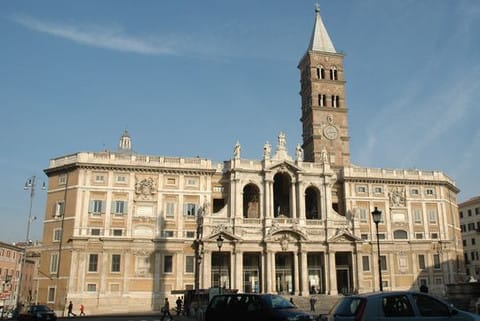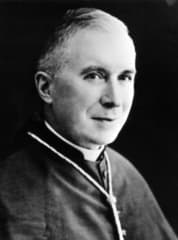主の御降誕の前日の説教
聖ピオ十世会司祭 ピーター・フォルティン神父様
特別な祝日には、典礼は私たちを、特定の祝日や玄義について重要な意味を持つ「指定巡礼聖堂」として知られているところへ連れていってくれます。聖人の祝日には、その聖人の名を冠した聖堂であることがあります。例えば、聖ステファノの祝日には、指定巡礼聖堂が殉教者聖ステファノ聖堂であるようにです。御降誕の前日には、御降誕の真夜中のミサと同様に、ローマ市の聖マリア大聖堂が指定巡礼聖堂だとされています。私は、この大バジリカの歴史からいくつかの事実を述べて、御降誕の前日における聖母の重要性について述べようと思います。
この教会の歴史は4世紀のローマで始まります。ある裕福で子どものいない夫婦が、自分たちが死んだあと、自分たちのこの地上での財産が童貞なる御母をたたえる方法で使われるように望んでいました。彼らは天主のお導きを祈り求めました。すると祝されし童貞が夢の中で夫にご出現になり、真夏に雪が降る場所に聖母のために教会を建てるようお求めになりました。
夫婦がすぐに、祝されし童貞の要請を教皇リベリウス(在位352-366)に報告したところ、教皇も同じような夢を見たと述べました。天候が最も暑かった8月5日に、雪が奇跡的に、ローマにあるエスクイリーノの丘と呼ばれる地域に、教会の輪郭を描くように降りました。
祝されし童貞をたたえた最初のキリスト教会が建てられました。最初は教皇リベリウスにちなんでリベリウスのバジリカと呼ばれました。何世紀にもわたって再建され、豪華に飾られたこのバジリカは、祝されし御母の母性と生涯を敬うローマ人や巡礼者にとって非常に特別な教会でした。

元のバジリカの建て直しと拡張が、431年のエフェゾ公会議のあとに行われました。この公会議は、特に天主の御母という聖母の称号についての論争を決着させるために招集されました。428年にコンスタンティノープル総大司教(大司教)に選ばれたネストリウスが、自らの非常に重要な立場を利用して、マリアはキリストの御母(クリストトコス)にすぎず、天主の御母(テオトコス。字義は「天主を生む者」)ではないという異端的な教理を唱えました。
ネストリウスとその一派の者たちは、イエズス・キリストのうちには人間と天主の二つの分離したペルソナがあり、マリアから生まれ、十字架に付けられ、死して葬られ、復活した人間のペルソナは天主のペルソナではない、と主張しました。ネストリウスとその支持者たちは、マリアはイエズスの天主のペルソナの母ではなく人間のペルソナの母にすぎないため、マリアを「天主の御母」と呼ぶことはできない、と論じました。
ネストリウスの異端への反対派を率いたのは、エジプトのアレキサンドリア総大司教の聖キリルスでした。キリルスは、イエズスには二つのペルソナはない、という教会の理解を明確にするのに貢献しました。そうではなく、イエズスは、一つは完全に人間の本性、もう一つは完全に天主の本性という二つの本性を結合させた唯一のペルソナとしてお生まれになったのです。その唯一のペルソナは天主であって、天主の永遠の御子です。マリアが肉となられたみ言葉をお生みになったとき、二つの本性をもつ唯一の天主のペルソナをお生みになりました。それゆえに、マリアは天主の御母と呼ばれるのが正しいのです。
この論争は、431年の6月から7月にかけてエフェゾで開かれたこの公会議で最高潮に達しました。200人近くの司教がそこに集まっていました。彼らはネストリウスを追放し、マリアはまことに天主の御母であると宣言しました。この公会議の決定は普遍的であって、キリスト教世界全体にマリアへの崇敬を増大させました。マグニフィカトにおいて、聖母は「よろず世に至るまで、人われを幸いなる者ととなえん」と言われました。今や、永遠に至るまで、聖母は幸いなる者ととなえられるのみならず、天主の御母というその最高の尊厳を持つ名前によって正しく知られるようになったのです。
エフェゾ公会議はネストリウスと彼の広めた異端説を公式に断罪したのですが、この論争は続きました。公会議が終了した一年後に教皇になった教皇シクストゥス三世(440年帰天)は、すぐにリベリウスのバジリカの再建に着手しました。修復の完成に当たって、教皇はこの聖堂を天主の御母たるマリアに奉献しました。教皇シクストゥスによるこの行為によって、エフェゾの公会議の教義宣言を聖座が認可したことが再確認されました。それはまた、天主の御母たる聖母に奉献されたこのローマのバジリカに、永遠に結びついたのです。

しばらくの間、このバジリカは、飼い葉桶の聖マリア聖堂として知られていました。御降誕のときにイエズスが寝かされていたものだと信じられていた聖なる飼い葉桶の聖遺物を入手したことにちなんでいたのです。この聖遺物は、7世紀のイスラムによる侵略から逃れた聖地からのキリスト教徒の避難民によってローマにもたらされました。このバジリカでは、今でも毎年御降誕祭の日に、聖なる飼い葉桶の行列を行っています。この教会は、最終的には聖マリア大聖堂と名付けられました。それは、祝されし御母をたたえてその御名を付けられたローマにある26の教会のうちで最も大きく、最も著名だったからです。私たちの精神と心が私たちの主を受け入れる準備ができるよう、特に本日、聖母に祈り求めましょう。
【英語原文】
Sermon for Vigil of Christmas
Fr Peter Fortin, FSSPX
For special feasts, the Liturgy will take us to what is known as “stational churches” which have a significance for the particular feast or mystery. For some feasts it will be the namesake of the saint such as for the feast of St. Stephan, the stational church is that of the Martyr, St. Stephan. For the Vigil of Christmas, there is mentioned the Station of St. Mary Major in the city of Rome as well with Christmas Midnight Mass. I will just mention a few facts from the history of this Major basilica to somehow describe the importance of Our Lady on the Vigil of Christmas.
The History begins in the fourth-century in Rome, there was a wealthy and childless couple who, upon their death, wanted their earthly possessions used in a way that would honor the Virgin Mother. They prayed for divine guidance. The Blessed Virgin appeared to the husband in a dream, requesting that a church be built for her on a site where snow would fall in midsummer.
The couple quickly reported the Blessed Virgin’s request to Pope Liberius (reigned 352-366), who claimed to have had a similar dream. On Aug. 5, when the weather was most hot, snow miraculously fell on an area of Rome called Esquiline Hill, depicting the outline of the church.
The first Christian church in honor of the Virgin Mary was built. It was first called the Liberian Basilica after Pope Liberius. This basilica, was rebuilt and magnificently adorned over the centuries, has been very special for Romans and pilgrims to venerate the maternity and life of the Blessed Mother.
Reconstruction and expansion of the original basilica took place following the ecumenical Council of Ephesus held in 431. That council was called specifically to settle a controversy regarding Our Lady’s title as the Mother of God. Nestorius, who was the patriarch (archbishop) of Constantinople elected in 428, used his very important position to preach the heretical doctrine that Mary was only the Mother of Christ (Christotokos), not the Mother of God (Theotokos; literally, “God-bearer”).
He and others claimed that there were two separate persons, one human and one divine, within Jesus Christ; and that the human person born of Mary, who was crucified, died, buried and resurrected was not divine. Nestorius and his followers argued that Mary could not be called “Mother of God,” because she was the mother only of the human person in Jesus, not the divine Person.
Leading the opposition to the Nestorian heresy was St. Cyril, patriarch of Alexandria, Egypt. Cyril helped to clarify the Church’s understanding that Jesus is not two persons. Rather, he was born one Person in whom are united two natures, one fully human and one fully divine. That one Person is the divine, eternal Son of God.
When Mary gave birth to the Word made flesh, she was giving birth to that one divine Person in two natures. Therefore Mary is rightfully called the Mother of God.
This controversy was brought to a head at the council in Ephesus during June and July 431. Nearly 200 bishops gathered there. They deposed Nestorius and declared that Mary is truly the Mother of God. The decision of the council was universal and increased the veneration of Mary throughout Christendom. In her Magnificat, Our Lady had said, “All generations will call me blessed”. Now, and for all eternity, not only would she be called blessed, but she would be duly known by the name of her highest dignity, Mother of God.
Though the Council of Ephesus officially condemned Nestorius and the heresy he promoted, the controversy continued. Pope St. Sixtus III (d. 440), who became pope one year after the council ended, immediately he began to rebuild the Liberian Basilica. Upon completion of the renovations, he dedicated it to Mary, the Mother of God. This action by Pope Sixtus further affirmed the Holy See’s approval of the council’s dogmatic declaration in Ephesus. It also linked forever this Roman basilica dedicated to Our Lady’s divine motherhood.
For a while the basilica was known as St. Mary of the Crib after it obtained a relic of the Holy Crib, believed to be the one in which Jesus was laid at His nativity. This relic was carried to Rome by Christian refugees from the Holy Land fleeing the Muslim invasion of the seventh century. The basilica still hosts a procession of the Holy Crib every year on Christmas Day. The church finally was named St. Mary Major because it is the largest and most eminent of all the 26 churches now in Rome named in honor of the Blessed Mother. Let us invoke Our Lady especially on this day to prepare our minds and hearts to receive Our Lord.











